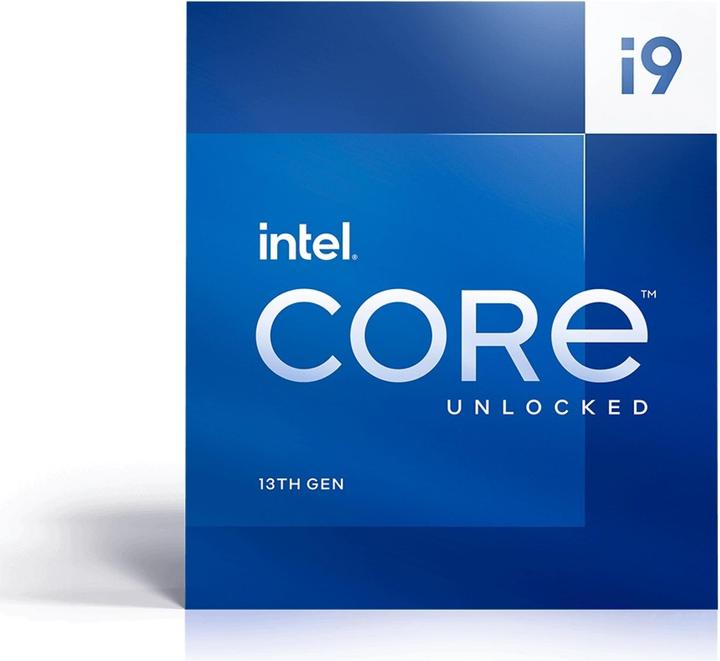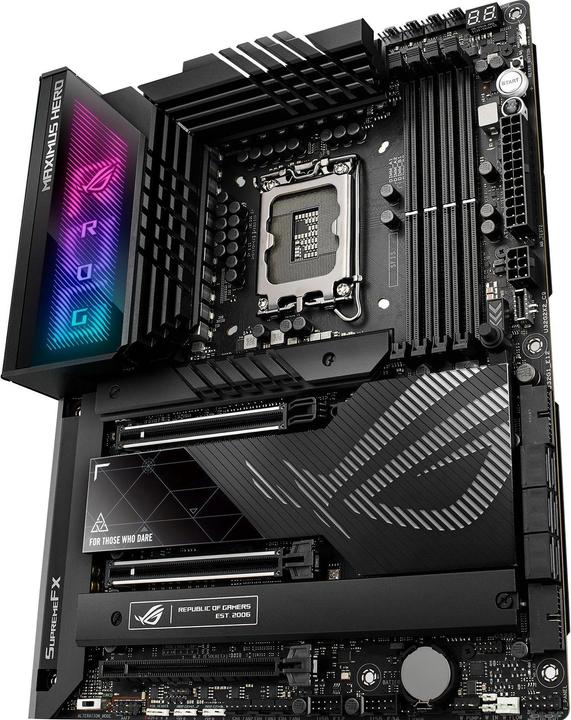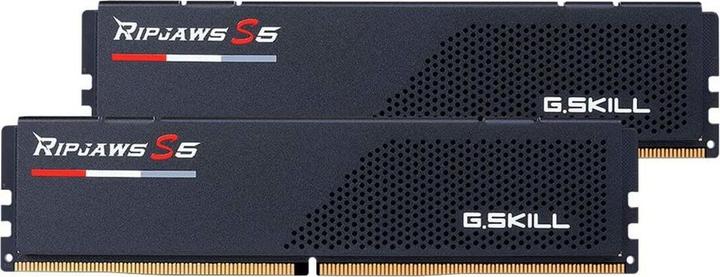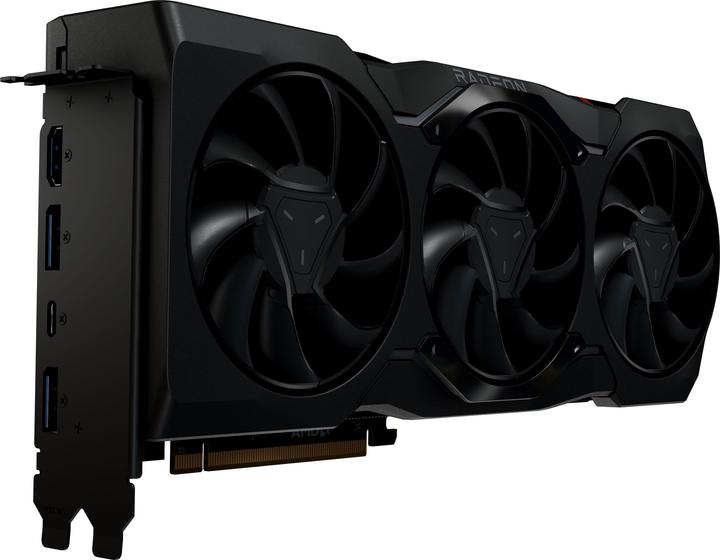

The Radeon RX 7900 XTX leaves me cold
AMD's current graphics card flagship takes on its Nvidia counterpart in the test. The card can only catch up in one area. In another, it at least wins the consolation prize.
With the RX 7900 XTX, AMD is again losing ground to Nvidia. It cannot keep up with the RTX 4080. Does that make it a bad graphics card? No, but it suffers from the same shortcoming as all the new models: it is too expensive.

Design and connections: Yep
The RX 7900 XTX looks downright cute compared to the RTX 4090 and RTX 4080. At 28.7 × 13.5 × 5.1 centimetres, the card should also fit into smaller systems than Nvidia's battleships. Three 85 millimetre fans and a heat sink should keep temperatures low. The card has two lighting zones: above and below the central fan. Overall, it looks well-made and sleek.
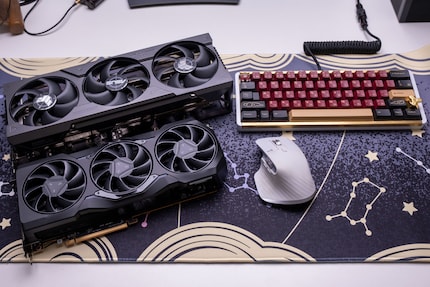
Source: Kevin Hofer
The RX 7900 XTX uses the PCIe 4.0 interface. It offers one HDMI 2.1 port and two DisplayPort 2.1 ports. With the first, up to 7680 × 4320 pixels at 60 Hz are possible. With the second, even 10 240 × 4320 with 60 Hz. A USB-C port rounds off the connectivity.
Specifications: First graphics card with chiplet design
The Radeon RX 7900 XTX relies on the third generation of the RDNA graphics architecture (RDNA3). New to the 7000 series is the chiplet design. The graphics unit is not manufactured in a monolithic process, but is composed of so-called chiplets. The central computing unit, the so-called Graphics Compute Die (GCD), is manufactured in a 5 nm process at TSMC. It benefits from the advanced manufacturing process. Components such as the L3 cache or memory controllers, the so-called memory cache die (MCD), benefit less from this. That is why they are manufactured in the 6nm process at TSMC. These individual elements are then combined to form the GPU. This should reduce production costs.
The chiplet design is not the only innovation. The Navi-31 GPU, which powers the RX 7900 XTX, has 96 processing units, 20 per cent more than the previous generation. They are supposed to enable 17.4 per cent higher instructions per cycle (IPC) at the same clock speed. According to AMD, the overall increase in performance is up to 54 percent. Here are the specifications at a glance:
| Sapphire AMD Radeon RX 7900 XTX | Asus Tuf Gaming GeForce RTX 4080 OC | Asus Rog Strix GeForce RTX 4090 OC | Nvidia GeForce RTX 3090 | |
|---|---|---|---|---|
| Architektur und Fertigung | RDNA 3.0 Navi 31 TSMC 5 und 6 nm | Ada Lovelace AD103-300-A1 TSMC N4 | Ada Lovelace AD102-300 TSMC N4 | Ampere GA102-300-A1 Samsung 8 nm |
| Shader-Einheiten | 6144 | 9728 | 16384 | 10496 |
| TMUs / ROPs | 384 / 192 | 304 / 112 | 512 / 128 | 328 / 112 |
| Basistakt | 1855 MHz | 2205 MHz | 2230 MHz | 1395 MHz |
| Boosttakt | 2499 MHz | 2625 MHz | 2520 MHz | 1695 MHz |
| Speicher | 24 GB GDDR6 | 16 GB GDDR6X | 24 GB GDDR6X | 24 GB GDDR6X |
| Speicherbus | 384 bit | 256 bit | 384 bit | 384 bit |
| Speicherbandbreite | 960 GB/s | 716.8 GB/s | 1008 GB/s | 936.2 GB/s |
| TDP | 355 Watt | 320 Watt | 450 Watt | 350 Watt |
Test setup and method
The following components I use for the review. They were provided to me by the manufacturers for testing:
The system runs on Windows 11 version 21H2 (22000.1098). I use BIOS version 0502 and enable XMP. Otherwise I leave everything on default, Resizable BAR is deactivated. For the graphics card, I use version 22.12.2 of the driver.
Here is an overview of the various benchmarks:
- Games: "Anno 1800", "Forza Horizon 5", "Assassin's Creed: Valhalla", "Civilization VI", "Cyberpunk 2077", "Far Cry 6", "Gears of War 5", "Red Dead Redemption 2", "Shadow of the Tomb Raider"
- Games with ray tracing: "Cyberpunk 2077", "Far Cry 6", "Shadow of the Tomb Raider"
- Fire Strike / Fire Strike Ultra
- Time Spy / Time Spy Extreme
- Blender Benchmark
- Photoshop
- Premiere
- PCMark 10
I run all benchmarks three times and take the best result. For the games, I use the highest possible default settings. Otherwise, I leave everything at default except for the resolution. I leave DLSS or FSR deactivated. In this review, I am interested in the rasterisation and ray tracing performance of the games without additional tools.
Games: Almost in step with Nvidia
for rasterizer games.
In the following slides you can see the arithmetic mean of the frames per second (FPS) of the nine benchmark games compared to the competition from Nvidia. Click on the galleries to see the results of the individual games
.
In the 1080p and 2160p resolutions, the RX 7900 XTX and its direct competitor RTX 4080 are no different. Only in 1440p does AMD have to admit defeat by just under two percent. Compared to the former Nvidia flagship RTX 3090, the AMD card is better by 10, 12 and 14 percent. As already announced by AMD itself, it is not enough for a battle with the RTX 4090, where the 7900 XTX is 23 percent behind in UHD.
After all, the AMD card does win a consolation prize. In terms of frame times in percentiles, it is ahead of the RTX 4080. The measured values of the percentiles are classically measured frame times in milliseconds. In other words, the time intervals from frame to frame. 99 percentile means that 99 percent of all measured values are faster than the specified measured value. In short: I had fewer jerks with the RX 7900 XTX in the tests than with the RTX 4080.
In the three ray-traced games, the RX 7900 XTX doesn't stand a chance. It lags between eleven percent in 2160p and 18 percent in 1080p resolution. In "Shadow of the Tomb Raider" and "Far Cry 6", the differences across all resolutions are not as enormous as in "Cyberpunk 2077". This is because in the first two games only shadows and reflections are ray-traced. In Cyberpunk, on the other hand, ambient occlusion and lighting are also ray-traced. This puts a heavier load on the graphics card.
Fire Strike, Fire Strike Ultra, Time Spy and Time Spy Ultra
In 3DMark's synthetic game benchmarks, game-like scenarios are rendered. From this, they calculate a score that indicates the theoretical performance in games. I only give you the values of the graphics card. This is because I always have big differences in the overall scores in the tests. The graph shows the arithmetic mean of the four benchmarks.
Except in the Fire Strike benchmark, the RX 7900 XTX is always ahead of the RTX 4080, but the differences are small, amounting to just 1.5 per cent across the four benchmarks.
Productivity benchmarks
The productivity benchmarks test the performance of the graphics cards and the entire system in various situations. The Blender Benchmark renders three scenes in version 3.4 in the 3D graphics suite and calculates three scores from them. I add these up to a final score in each case. The Photo Editing Benchmark and Video Editing Benchmark UL Procyon simulate different workloads in the Adobe Creative Suite. At the end, the benchmark calculates a score. For the sake of clarity, I have summarised the average value of all scores in a graph.
In terms of productivity, the new AMD card doesn't stand a chance against the competition from Nvidia. It can't even hold its own against the former flagship RTX 3090. The difference to the RTX 4080 is 35 percent. It is particularly large in the Blender benchmark. That the card does not do well in the Adobe benchmarks is not surprising. Adobe is very slow when it comes to adapting software to new hardware. If I were to run the benchmark again in a month or two, a better result would show up here. But this also applies to the two new Nvidia graphics cards.
Power consumption, volume and temperature
The maximum thermal design power (TDP) of 355 watts is rarely reached by the RX 7900 XTX, but it comes close. On average, the power consumption is 347 watts in 2160p resolution across the entire benchmark suite. This means that the AMD card requires about the same amount of power as the RTX 4090 with 340 watts. Compared to the RTX 4080, the AMD card is significantly hungrier: The competitor needs just 270 watts. More precisely: for the same result, the 7900 XTX needs 28.5 per cent more power than the 4080. A 750-watt power supply should nevertheless suffice.
.
The temperatures reach a maximum of 66 degrees Celsius in games. On average, I measured 64 degrees Celsius across all games on the open testbench.
The performance of the 4080 is the same.
The card demands just as much performance as in games in the Time Spy Extreme benchmark. It also gets warmer with a maximum of 70 degrees Celsius. At full load with FurMark for 20 minutes, the maximum temperature is 73 degrees Celsius. At the same time, the fans are clearly audible with a maximum of 45.5 dB from 30 centimetres away.
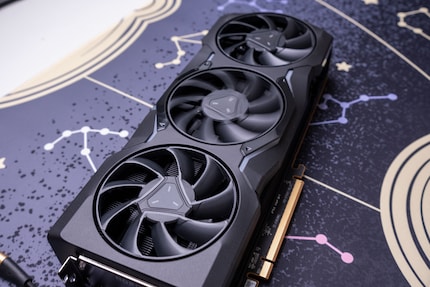
Source: Kevin Hofer
Talking about noise: in idle mode, almost nothing can be heard from the card at 35 dB, although the fans operate at 500 revolutions per minute. Thus, the 7900 XTX draws 17 watts and stays cool at 38 degrees Celsius. But that's significantly more than the RTX 4080, which only needs 5 watts and gets 28 degrees Celsius. When I'm browsing or watching Netflix, the AMD card draws up to 55 watts of power, but doesn't get hotter than 43 degrees Celsius. These are also higher values than with the RTX 4080 at 32 watts line and a temperature of 40 degrees Celsius.
Lastly, I measured the power consumption during the Blender benchmark. Here, the RX 7900 XTX draws an average of 347 watts, just like in the games, and gets hot to a maximum of 66 degrees Celsius. This is a big difference to the RTX 4080, which only needs 205 watts on average and gets hot to a maximum of 54 degrees Celsius.
Conclusion: AMD needs to go over the books
When AMD introduced the Radeon 6000 series just over two years ago, it was a smash hit. For the first time in years, the cards were comparable to those from Nvidia. Especially in terms of efficiency, they outperformed the competition. I had correspondingly high expectations for the Radeon 7000 series. Unfortunately, they were disappointed.
AMD can still keep up with Nvidia in classic rasteriser games, but the wind has changed in terms of efficiency: the RTX 4080 achieves around 0.4 FPS per watt in UHD resolution in my benchmark games. The RX 7900 XTX achieves just 0.32. The result is even clearer in the Blender benchmark: per watt, the Nvidia card delivers 45.5 points, while the AMD card delivers a measly 10.5. In the productivity benchmarks, it is mercilessly beaten into the ground in terms of scores. The same happens in ray-tracing games, where the RTX 4080 delivers up to 18 percent more FPS.
AMD therefore has to go over the price to be competitive. 1179 francs or euros is the price of the card at market launch. This is the reference model. That means: manufacturers like Sapphire in this case take over AMD's design and sell it under their own name. Of Nvidia's RTX 4080, I tested the Asus TUF Gaming GeForce RTX 4080 OC Edition. At the time of release, it cost 480 francs more than the AMD card tested. This is a so-called custom model. These are the manufacturers' own designs, which are usually more expensive. The price comparison is therefore not entirely fair. For a custom model of the 7900 XTX, you have to pay about 200 francs more than for the reference model. In other words, the price difference to the RTX 4080 is still around 280 francs. If you only want to play classic Rasterizer games, the price seems fair. But I contrast this with two other things:
- Ray tracing is the future. More and more games will rely on it and at some point it will become the standard. So AMD urgently needs to come up with something to catch up with Nvidia. The difference is currently too great and AMD is in danger of losing touch. Nvidia simply offers more for the money.
- I have already described the RTX 4080 as too expensive. I say the same about the RX 7900 XTX. Anything over 1000 francs is extortionate, 800 francs would be fair.
I can only recommend the RX 7900 XTX if your wallet is loose and you only play Rasterizer games. Then it delivers more frames per franken than the RTX 4080 - but at the cost of FPS per watt. In all other situations, AMD's new flagship is a bad deal.
Titelbild: Kevin Hofer
From big data to big brother, Cyborgs to Sci-Fi. All aspects of technology and society fascinate me.
